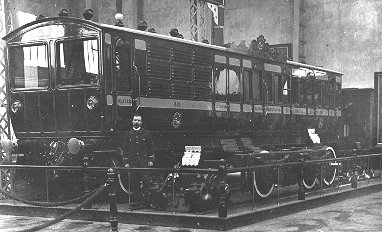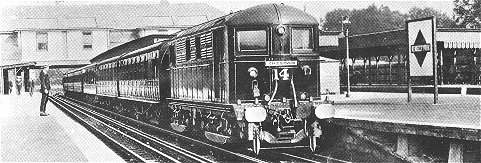
Suburban Electric Railway Association
Located at the COVENTRY ELECTRIC RAILWAY CENTRE, Rowley Road, Baginton, Warwickshire
Established
1996
The History Zone
Electrifying London
MetroLand
The Metropolitan Railway (MET) operated over the northern side of the Inner Circle from Aldgate where it ran trains to Aylesbury via Baker Street, Harrow-On-The-Hill and Rickmansworth, the MET also had branch lines from Paddington to Hammersmith (Hammersmith & City Railway - joint with the GWR), Harrow to Uxbridge and from Chalfont to Chesham. Under the direction of it's Chairman, Sir Edward Watkin, the MET played a vital part in the plan Watkin conceived to transport passengers from Manchester to Dover and onward to the continent via a channel tunnel using the three railways Watkin controlled, namely the Great Central, The South Eastern and of course the MET; grand plans indeed.
By the turn of the century the MET had to act to improve its service to the suburbs, which despite Watkins grand dreams was really the bread and butter traffic to the railway. Electrification of the Inner Circle (in co-operation with the District Railway) and the Hammersmith and City branch along with the main line to Harrow and the Uxbridge branch was completed during 1905/06. The MET employed EMUs which were like those early units of the District being American in outline with clerestory roofs, saloon interiors with Gate end platforms, the later feature was not successful for the mainly open air MET and only the first batches had the feature which was soon modified to provide enclosed vestibule ends.
For the METs longer distance services the need for steam traction continued on lines north of Harrow but for the journey from this point to and from the city steam was replaced. At first the MET converted it's bogie stock to be hauled or propelled by a standard EMU motor coach as the MET equipped all of their such vehicles with four traction motors and felt they would be adequately powered for the task. This proved not to be the case and the MET invested in a fleet of 20 Bo-Bo electric locomotives to haul it's bogie coaches from Harrow to the City and back. The first ten of these locos arrived in 1906 and they had a tall central cab with an angled bonnet either side of it house the traction and brake control equipment. The second batch of ten locos arrived a year later and had a flat fronted box like appearance. Also in 1906 the MET converted numbers of the former steam hauled bogie coaches into EMUs to provide cheap options to supplement the existing fleet, a converted motor coach of one such set is pictured below.

The MET became the first railway in Britain to offer an electrically hauled Pullman service when it provided one such car in the consist of certain commuter workings between Aldgate and Aylesbury. The Arrival of brand new elliptical roof saloon EMU stock for circle and Uxbridge line trains occurred either side of the First World War.
The MET had plans to electrify all the way from Harrow to Aylesbury in the early twenties and also to build a new branch line to Watford. Only the later was fully achieved, the branch from Moor Park to Watford opened on the 02/11/25 whilst the extension of the electrified lines got as far as was ever to reach under Metropolitan Railway control when Rickmansworth went live on the 05/01/25. To work the Watford service new stock was required but in keeping with previous MET practice it was only part new. 12 new motor coaches were delivered from Metro-Carriage in 1927 which were roughly the same outline as the 1912 built MET bogie steam hauled stock with all accommodation in compartments. The new motor coaches had each of their four axles motored and between the driving cab and luggage compartment was a compartment where the banks of electro pneumatic contactors for the control of the motor equipment were housed. The trains ran with five converted steam hauled compartment coaches marshalled between the motor coaches. Subsequent batches of motor coaches and purpose built compartment trailer coaches were delivered in 1931 & 1932, the units were classified as T stock (pictured below) and remained in use on the Watford services until 1962.

The MET had also taken delivery in 1922/23 of twenty new electric locomotives to replace the earlier locos which were underpowered for the longer haul to Rickmansworth. The new locos were also Bo-Bo arrangement but had slimline bodies with a blunt V shaped cab end. All of them were named after prominent historical figures with connection to the locality served by th MET, Sherlock Holmes and Sir Ralph Verney. These locos hauled the Aylesbury trains of bogie stock from Aldgate as far as Rickmansworth where they were changed for steam traction for the remainder of the journey, one of the features of this service was the highly efficient changeover of locomotives that usually took as little as three minutes to achieve ! Locomotive haulage ceased in 1961.

One of the last acts of the Metropolitan Railway was the building of the branch from Wembley Park to Stanmore which opened in December 1932, included with the programme to build this branch was the four tracking of the section of line from Wembley to Harrow.
The Metropolitan Railway was keen to promote the virtues of residence in the suburban districts served by it's services and coined the phrase 'MetroLand' to describe them. Posters adorned stations and train interiors advising travelers to 'Come Live In MetroLand'.
The formation of the London Passenger Transport Board on July 1st 1933 which resulted in the nationalisation of the MET, District and all other tube lines in the UERL group had little immediate effect on the operation and appearance of what became known as the Metropolitan Line, in due course new trains alterations to stations and services and extension of the electrification would come but even after all this the MET still retained a distinctive air all of it's own.
Continue to part Eight -
The East London Line & Great Northern And City Railway
